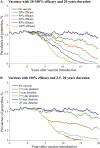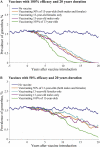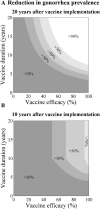The potential impact of vaccination on the prevalence of gonorrhea
- PMID: 26192351
- PMCID: PMC4743649
- DOI: 10.1016/j.vaccine.2015.07.015
The potential impact of vaccination on the prevalence of gonorrhea
Abstract
Gonorrhea, one of the most common sexually transmitted infections worldwide, can lead to serious sequelae, including infertility and increased HIV transmission. Recently, untreatable, multidrug-resistant Neisseria gonorrhoeae strains have been reported. In the absence of new antibiotics, and given the speed with which resistance has emerged to all previously used antibiotics, development of a vaccine would be the ideal solution to this public health emergency. Understanding the desired characteristics, target population, and expected impact of an anti-gonococcal vaccine is essential to facilitate vaccine design, assessment and implementation. The modeling presented herein aims to fill these conceptual gaps, and inform future gonococcal vaccine development. Using an individual-based, epidemiological simulation model, gonococcal prevalence was simulated in a heterosexual population of 100,000 individuals after the introduction of vaccines with varied efficacy (10-100%) and duration of protection (2.5-20 years). Model simulations predict that gonococcal prevalence could be reduced by at least 90% after 20 years, if all 13-year-olds were given a non-waning vaccine with 50% efficacy, or a vaccine with 100% efficacy that wanes after 7.5 years. A 40% reduction in prevalence is achievable with a non-waning vaccine of only 20% efficacy. We conclude that a vaccine of moderate efficacy and duration could have a substantive impact on gonococcal prevalence, and disease sequelae, if coverage is high and protection lasts over the highest risk period (i.e., most sexual partner change) among young people.
Keywords: Antimicrobial resistance; Epidemiological simulation model; Gonorrhea; Neisseria gonorrhoeae; Vaccine.
Copyright © 2015 The Authors. Published by Elsevier Ltd.. All rights reserved.
Figures



References
-
- WHO . Global action plan to control the spread and impact of antimicrobial resistance in Neisseria gonorrhoeae. World Health Organization (WHO), Department of Reproductive Health and Research; 2012. 2012. Available from http://www.who.int/reproductivehealth/publications/rtis/9789241503501/en/
-
- CDC. Antibiotic Resistance Threats in the United States. 2013 2013. Available from http://www.cdc.gov/drugresistance/threat-report-2013/pdf/ar-threats-2013....
-
- Tapsall J. Antibiotic resistance in Neisseria gonorrhoeae is diminishing available treatment options for gonorrhea: some possible remedies. Expert Rev Anti Infect Ther. 2006;4:619–28. - PubMed
Publication types
MeSH terms
Substances
Grants and funding
LinkOut - more resources
Full Text Sources
Other Literature Sources
Medical

